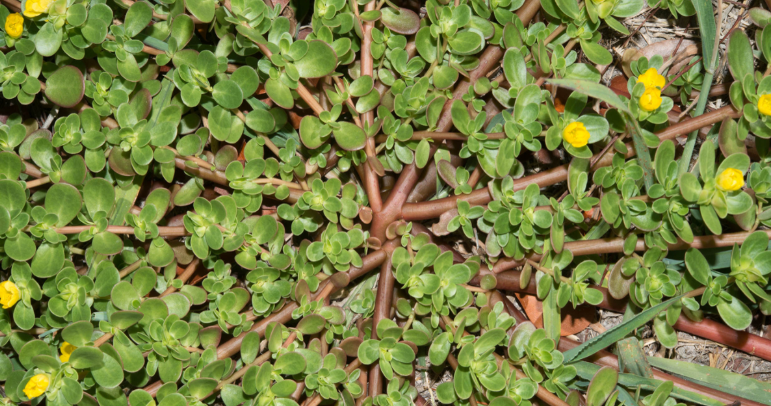This Super Weed’s Clues for Drought-Resilient Turfgrass
- June Griffin

- Jul 8
- 3 min read
Updated: Jul 18

By June Griffin, B.S., B.A. & David Santos, MBiotech
Photosynthetic pathways play a pivotal role in how plants adapt to drought, heat, and shifting weather conditions. Recent research from Yale University and collaborators has uncovered a remarkable example in Portulaca oleracea, or purslane, an ordinary roadside weed with an extraordinary strategy [1]. Purslane uniquely combines C4 photosynthesis, which supports high growth and productivity, with CAM, which conserves water during drought stress. This rare blend of pathways could inspire future breakthroughs in engineering drought-tolerant crops and perhaps even turfgrass species.
Curious how beneficial microbes can help plants cope with drought and high salinity?
Types of Photosynthetic Processes
Plants have independently developed a range of unique strategies to enhance photosynthesis, the process by which plants use sunlight to convert carbon dioxide and water into nutrients.
Most plants use a photosynthetic process called C3, which is efficient under mild conditions but loses effectiveness in drought and heat. Some plants have evolved alternative pathways: C4 photosynthesis and CAM (Crassulacean Acid Metabolism) [2].
C4 plants, like maize and sugarcane, separate carbon dioxide fixation and sugar production between different cell types, making them more efficient in hot, sunny environments.
CAM plants, like cacti and succulents, fix carbon dioxide at night, storing it to use during the day, which helps conserve water.
Until now, it was thought that plants could use either C4 or CAM, but not both together.
Most cool-season turfgrasses, like Kentucky bluegrass (Poa pratensis) and creeping bentgrass (Agrostis stolonifera), use the C3 photosynthetic pathway, which performs best under moderate temperatures and adequate moisture. In contrast, warm-season turfgrasses such as bermudagrass (Cynodon dactylon) and zoysiagrass (Zoysia japonica) use the C4 pathway, making them more water-use efficient and better adapted to heat and drought.
What Makes this Super Weed So Powerful?
The study revealed P. oleracea can combine C4 and CAM photosynthesis within the same cells. During drought, the plant switches on CAM to conserve water, while still benefiting from the high-efficiency sugar production of C4 [1,2].
This hybrid system offers an “unprecedented metabolic flexibility,” enabling the plant to stay productive under both drought and well-watered conditions. For golf course superintendents, this trait exemplifies the kind of resilience that turfgrass breeders aim to replicate: maintaining growth and quality during dry spells without excessive irrigation.
Courses using En-Turf are seeing denser roots, greener grass, and healthier turf results that keep players coming back.
The Future of Drought-Resistant Crop Engineering
Understanding how P. oleracea coordinates C4 and CAM at the molecular level could help scientists design turfgrass and other crops that can dynamically switch between photosynthetic modes.
Erika Edwards, a professor of Ecology and Evolutionary Biology at Yale University, stated: “This is a very rare combination of traits and has created a kind of ‘super plant’ — one that could be potentially useful in endeavors such as crop engineering” [3].
Instead of relying solely on irrigation or selecting purely drought-tolerant species, future turf cultivars might actively adapt their metabolism to weather patterns. Such innovation could reduce water use while preserving turf density and playability, a critical goal as courses face increasing environmental and regulatory pressure to conserve water.
Conclusion
From an overlooked weed to a scientific breakthrough, Portulaca oleracea offers an inspiring glimpse into nature’s solutions for drought resilience. As research progresses, golf course superintendents could one day benefit from turfgrass varieties that harness similar flexibility, thriving under both drought and normal conditions. By staying informed on these advances, superintendents can be ready to integrate next-generation turf strategies that balance performance and sustainability. The road ahead may be shaped as much by discovery as by design, and even weeds can hold the blueprint for a greener future.
References
[1] Hathaway, B. (2024, October 6). Common weed may be “Super Plant” that holds key to drought-resistant crops. Yale News. https://news.yale.edu/2022/08/05/common-weed-may-be-super-plant-holds-key-drought-resistant-crops
[2] Moreno-Villena, J. J., Zhou, H., Gilman, I. S., Tausta, S. L., Cheung, C. Y., & Edwards, E. J. (2022). Spatial resolution of an integrated C4+cam photosynthetic metabolism. Science Advances, 8(31). https://doi.org/10.1126/sciadv.abn2349
[3] Boyle, R. (2022, August 8). This common “super plant” could inspire drought-resistant crops. Discover Magazine. https://www.discovermagazine.com/environment/this-common-super-plant-could-inspire-drought-resistant-crops


